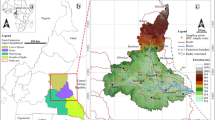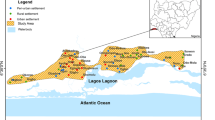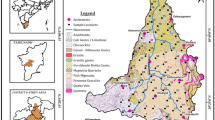Abstract
This research examines groundwater quality in terms of its appropriateness for drinking and agricultural use, the possible human health hazards associated with arsenic exposure, the role of industries in contaminating groundwater, and their impact on the surrounding community. The drinking water assessment includes the examination of physical and chemical parameters to determine compliance with national and international standards. The study emphasizes the requirement for efficient groundwater management and monitoring to guarantee its safe and long-lasting usage for agricultural and drinking reasons. Observing the hydrogeochemical properties helps scientists to thoroughly understand groundwater pollution. Twenty-two samples were collected from the district of Faisalabad city in Punjab, Pakistan. This study aimed to investigate groundwater quality and hydrogeochemical characteristics in Faisalabad city. Groundwater samples were collected from various wells and boreholes and were analyzed using various analytical techniques to determine their physical and chemical properties. The results of the study were then used to identify potential sources of contamination and to assess the overall quality of the groundwater. In addition, the study evaluated the hydrogeochemical processes that affect the area’s quality and availability of groundwater.











Similar content being viewed by others
REFERENCES
ONU, The sustainable development goals report 2019, United Nations Publ. Iss. by Dep. Econ. Soc. Aff. (2022).
H. Rasheed, F. Altaf, K. Anwaar, and M. Ashraf, Drinking Water Quality in Pakistan: Current Status and Challenges (Pakistan Council of Research in Water Resources, 2021).
W. J. Young, Pakistan getting more water, Report No. 141402 (World Food Bank, 2019).
M. Azhar, M. Mobeen, T. Aziz, A. Rehman, M. Mohsin, and M. Sajid, Pak. J. Sci. 73 (1), 199–212 (2021).
H. Zulfiqar, Q. Abbas, A. Raza, and A. Ali, J. Glob. Innov. Agric. Soc. Sci. 4 (1), 40–45 (2016). https://doi.org/10.17957/jgiass/4.1.731
J. Siddique, J. Menggui, M. H. Shah, A. Shahab, F. Rehman, and U. Rasool, Geofluids 2020, 6621038 (2020). https://doi.org/10.1155/2020/6621038
J. Wandrey Craig and E. Law Ben, USGS Geology Map of South Asia (U. S. Dep. Inter. Geol. Surv., 2000).
F. Chen, L. Yao, G. Mei, Y. Shang, F. Xiong, and Z. Ding, Water (Switzerland) 13 (6) (2021). https://doi.org/10.3390/w13060783
S. U. Shahid and J. Iqbal, IOP Conf. Ser. Earth Environ. Sci. 44 (4) (2016). https://doi.org/10.1088/1755-1315/44/4/042031
J. Y. Hwang et al., J. Agric. Chem. Environ. 6 (1), 1–29 (2017). https://doi.org/10.4236/jacen.2017.61001
F. K. Zaidi, O. M. K. Kassem, A. M. A-Bassam, and S. Al-Humidan, Arab. J. Sci. Eng. 40 (7), 1977–1985 (2015).
N. Das, P. Mondal, R. Ghosh, and S. Sutradhar, SN Appl. Sci. 1 (8) (2019). https://doi.org/10.1007/s42452-019-0841-5
M. Shammi et al., Sust. Water Resour. Manag. 2 (4), 369–378 (2016). https://doi.org/10.1007/S40899-016-0064-5/FIGURES/6
P. Sangwan, M. S. Rishi, and G. Singh, Tox. Rev. 41 (2), 536–550 (2022). https://doi.org/10.1080/15569543.2021.1906707
Y. Zhang et al., J. Environ. Manag. 237, 163–169 (2019). https://doi.org/10.1016/j.jenvman.2019.02.067
M. A. Kamal, M. U. Arshad, and B. A. Zaidi, J. Eng. Appl. Sci. 17, 1–10 (2015).
H. I. Owamah, J. Technol. 38 (2), 526 (2019). https://doi.org/10.4314/njt.v38i2.32
A. Marandi and P. Shand, Appl. Geochem. 97, 209–212 (2018). https://doi.org/10.1016/j.apgeochem.2018.07.009
S. Acharya, S. K. Sharma, and V. Khandegar, Data Br. 18, 2019–2028 (2018). https://doi.org/10.1016/j.dib.2018.04.120
Funding
This work was supported by ongoing institutional funding. No additional grants to carry out or direct this particular research were obtained.
Author information
Authors and Affiliations
Corresponding author
Ethics declarations
The authors of this work declare that they have no conflicts of interest.
Additional information
Publisher’s Note.
Pleiades Publishing remains neutral with regard to jurisdictional claims in published maps and institutional affiliations.
Rights and permissions
About this article
Cite this article
Awan, A.A., Rehman, F., Azeem, T. et al. Multi-dimensional Assessment of Groundwater Quality Correlating with Textile Mills in Faisalabad City, Pakistan. Dokl. Earth Sc. (2024). https://doi.org/10.1134/S1028334X23603449
Received:
Revised:
Accepted:
Published:
DOI: https://doi.org/10.1134/S1028334X23603449




